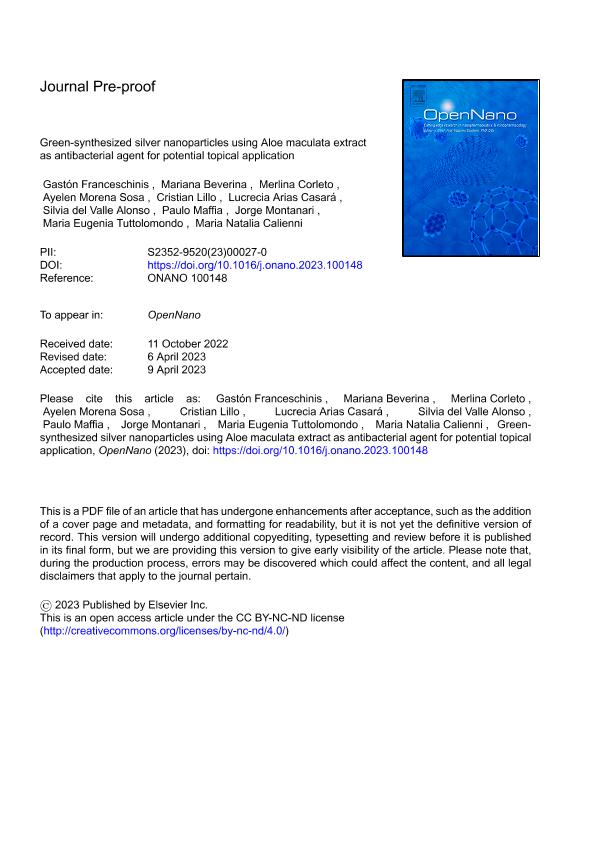Artículo
Green-synthesized silver nanoparticles using Aloe maculata extract as antibacterial agent for potential topical application
Franceschinis, Gaston Oscar ; Beverina, Mariana; Corleto, Ingrid Merlina
; Beverina, Mariana; Corleto, Ingrid Merlina ; Sosa, Ayelen Morena
; Sosa, Ayelen Morena ; Lillo, Rolando Cristian Rodrigo
; Lillo, Rolando Cristian Rodrigo ; Arias Cassará, María Lucrecia
; Arias Cassará, María Lucrecia ; Alonso, Silvia del Valle
; Alonso, Silvia del Valle ; Maffia, Paulo Cesar
; Maffia, Paulo Cesar ; Martinetti Montanari, Jorge Anibal
; Martinetti Montanari, Jorge Anibal ; Tuttolomondo, María Eugenia; Calienni, Maria Natalia
; Tuttolomondo, María Eugenia; Calienni, Maria Natalia
 ; Beverina, Mariana; Corleto, Ingrid Merlina
; Beverina, Mariana; Corleto, Ingrid Merlina ; Sosa, Ayelen Morena
; Sosa, Ayelen Morena ; Lillo, Rolando Cristian Rodrigo
; Lillo, Rolando Cristian Rodrigo ; Arias Cassará, María Lucrecia
; Arias Cassará, María Lucrecia ; Alonso, Silvia del Valle
; Alonso, Silvia del Valle ; Maffia, Paulo Cesar
; Maffia, Paulo Cesar ; Martinetti Montanari, Jorge Anibal
; Martinetti Montanari, Jorge Anibal ; Tuttolomondo, María Eugenia; Calienni, Maria Natalia
; Tuttolomondo, María Eugenia; Calienni, Maria Natalia
Fecha de publicación:
07/2023
Editorial:
Elsevier Inc
Revista:
OpenNano
ISSN:
2352-9520
Idioma:
Inglés
Tipo de recurso:
Artículo publicado
Clasificación temática:
Resumen
Nowadays, antibiotic resistance poses a threat to public health worldwide. For this reason, non-traditional antibacterial products, such as silver nanoparticles (AgNPs), offer an opportunity to address this issue. Although AgNPs have been proven to be effective antimicrobial agents, we studied the antibacterial and antibiofilm effects of two novel AgNPs (AgNP-Aloe-1 and AgNP-Aloe-2) obtained by green synthesis, their cytotoxicity on a cell line derived from human keratinocytes, and their skin penetration. These AgNPs were obtained here for the first time from an Aloe maculata aqueous extract as a reducing and capping agent of Ag(I), with varying the initial silver concentrations (5 and 9 mM of AgNO3 for AgNP-Aloe-1 and AgNP-Aloe-2, respectively). For all the assessments, these were compared with AgNPs obtained from a traditional chemical method employing hydroxylamine hydrochloride as a reducing agent and AgNO3 (AgNP–NH2OH·HCl). The AgNPs were characterized physicochemically by TEM, DLS, Zeta potential, UV–vis, fluorescence, and Raman spectroscopy. Additionally, the concentration of silver forming AgNPs and the reaction yield were determined. Both green-synthesized AgNPs showed an improvement in the inhibition of bacterial growth after 24 h of incubation for E. coli and S. aureus. AgNP-Aloe-1 presented a MIC 4 times lower for both bacteria compared to AgNP–NH2OH·HCl, while AgNP-Aloe-2 presented a MIC 32 and 8 time lower for E. coli and S. aureus, respectively. Moreover, they produced a decrease in the biofilm biomass formation from P. aeruginosa at lower concentrations (6.25 μg/ml for AgNP-Aloe-1 and 1.56 μg/ml for AgNP-Aloe-2) than AgNP-NH2OH·HCl which only showed a reduction of 30% at the maximum concentration tested. However, AgNP-Aloe-1 and AgNP-Aloe-2 were less efficient in eradicating pre-formed biofilm. Even though AgNP-Aloe-2 showed a lower reaction yield (31.7%) compared to AgNP-Aloe-1 (68.5%), they showed the best antibacterial activity. On the other hand, green-synthesized AgNPs were mainly retained in the stratum corneum of intact skin and reached lower concentrations in the viable epidermis than AgNP–NH2OH·HCl. Moreover, AgNP-Aloe-1 and AgNP-Aloe-2 did not show cytotoxic effects on human keratinocytes at the antibacterial concentrations. Their improved performance and lower skin penetration could be attributed to their physicochemical properties, such as size (10–25 nm), charge (around −10 mV), and shape (tendency towards a spherical shape), but mainly to the presence of phytocompounds from the extract that remained attached to the AgNPs, as observed by Raman spectroscopy and UV–vis. For the reasons mentioned above, these novel AgNPs obtained by a more environmentally friendly method have the potential to be used as antibacterial agents, particularly for topical applications.
Palabras clave:
ANTIBACTERIAL
,
ANTIBIOFILM
,
CYTOTOXICITY
,
SILVER NANOPARTICLES
,
SKIN PENETRATION
Archivos asociados
Licencia
Identificadores
Colecciones
Articulos(IMBICE)
Articulos de INST.MULTIDISCIPL.DE BIOLOGIA CELULAR (I)
Articulos de INST.MULTIDISCIPL.DE BIOLOGIA CELULAR (I)
Articulos(INBIOFAL)
Articulos de INSTITUTO DE BIOTECNOLOGÍA FARMACEUTICA Y ALIMENTARIA
Articulos de INSTITUTO DE BIOTECNOLOGÍA FARMACEUTICA Y ALIMENTARIA
Articulos(INIFTA)
Articulos de INST.DE INV.FISICOQUIMICAS TEORICAS Y APLIC.
Articulos de INST.DE INV.FISICOQUIMICAS TEORICAS Y APLIC.
Articulos(INQUINOA)
Articulos de INST.DE QUIMICA DEL NOROESTE
Articulos de INST.DE QUIMICA DEL NOROESTE
Articulos(SEDE CENTRAL)
Articulos de SEDE CENTRAL
Articulos de SEDE CENTRAL
Citación
Franceschinis, Gaston Oscar; Beverina, Mariana; Corleto, Ingrid Merlina; Sosa, Ayelen Morena; Lillo, Rolando Cristian Rodrigo; et al.; Green-synthesized silver nanoparticles using Aloe maculata extract as antibacterial agent for potential topical application; Elsevier Inc; OpenNano; 12; 7-2023; 1-25
Compartir
Altmétricas



